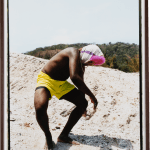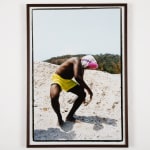ABRE ALAS #17
Caio Rosa, sem título [untitled], 2021
ampliação manual e impressão C-Print. [manual enlargement and C-Print.]
83 x 58.5 cm
[32 5/8 x 23 1/8 in]
[32 5/8 x 23 1/8 in]
Copyright The Artist
Further images
Visões do Luvemba* busca construir pontes entre a cultura Bate-bola nascida nos subúrbios do Rio de Janeiro e as culturas tradicionais africanas preservadas. A ideia central é utilizar como base...
Visões do Luvemba* busca construir pontes entre a cultura Bate-bola nascida nos subúrbios do Rio de Janeiro e as culturas tradicionais africanas preservadas. A ideia central é utilizar como base de investigação o elemento mãe das fantasias: a máscara, com ênfase nas simbologias da diáspora africana.
Partindo dessa cultura tradicional dos subúrbios cariocas, onde foi nascido e criado, os Bate-bolas nascem na década de 1930 nos bairros da zona norte e oeste do Rio de Janeiro, com grande influência das Folias de Reis do Brasil e outras tradições de máscaras de matriz africana como Likumbi Lya Mize do nordeste da África, por exemplo, evoluindo com grande liberdade e, de certa forma marginalizados do carnaval “oficial” carioca, que se caracteriza pelos desfiles de blocos de foliões comuns pelas zonas central e sul da cidade.
//
Visões do Luvemba* seeks to build bridges between the Bate-bola culture born in the suburbs of Rio de Janeiro and the preserved traditional African cultures. The central idea is to use the mother element of the costumes as a research base: the mask, with emphasis on the symbologies of the African diaspora.
Starting from this traditional culture in the suburbs of Rio de Janeiro, where he was born and raised, the Bate-bolas were born in the 1930s in the northern and western neighborhoods of Rio de Janeiro, with great influence of the Folias de Reis of Brazil and other traditions of masks of African origin such as Likumbi Lya Mize of northeastern Africa, for example, evolving with great freedom and somehow marginalized from the "official" carnival of Rio de Janeiro, which is characterized by the carnival street parties common in the central and southern zones of the city.
Partindo dessa cultura tradicional dos subúrbios cariocas, onde foi nascido e criado, os Bate-bolas nascem na década de 1930 nos bairros da zona norte e oeste do Rio de Janeiro, com grande influência das Folias de Reis do Brasil e outras tradições de máscaras de matriz africana como Likumbi Lya Mize do nordeste da África, por exemplo, evoluindo com grande liberdade e, de certa forma marginalizados do carnaval “oficial” carioca, que se caracteriza pelos desfiles de blocos de foliões comuns pelas zonas central e sul da cidade.
//
Visões do Luvemba* seeks to build bridges between the Bate-bola culture born in the suburbs of Rio de Janeiro and the preserved traditional African cultures. The central idea is to use the mother element of the costumes as a research base: the mask, with emphasis on the symbologies of the African diaspora.
Starting from this traditional culture in the suburbs of Rio de Janeiro, where he was born and raised, the Bate-bolas were born in the 1930s in the northern and western neighborhoods of Rio de Janeiro, with great influence of the Folias de Reis of Brazil and other traditions of masks of African origin such as Likumbi Lya Mize of northeastern Africa, for example, evolving with great freedom and somehow marginalized from the "official" carnival of Rio de Janeiro, which is characterized by the carnival street parties common in the central and southern zones of the city.
![ABRE ALAS #17, Caio Rosa, sem título [untitled], 2021](https://artlogic-res.cloudinary.com/w_1800,h_1320,c_limit,f_auto,fl_lossy,q_auto/artlogicstorage/agentilcarioca/images/view/ad03e96969a0ff459e85179713939d8ep/agentilcarioca-abre-alas-17-caio-rosa-sem-t-tulo-untitled-2021.png)
![ABRE ALAS #17, Caio Rosa, sem título [untitled], 2021](https://artlogic-res.cloudinary.com/w_1800,h_1320,c_limit,f_auto,fl_lossy,q_auto/artlogicstorage/agentilcarioca/images/view/e3ca1da9f31ee8b7be3879eb4672705ej/agentilcarioca-abre-alas-17-caio-rosa-sem-t-tulo-untitled-2021.jpg)
![ABRE ALAS #17, Caio Rosa, sem título [untitled], 2021](https://artlogic-res.cloudinary.com/w_1800,h_1320,c_limit,f_auto,fl_lossy,q_auto/artlogicstorage/agentilcarioca/images/view/01b4f1df25368dfd31b56dc346be5d42j/agentilcarioca-abre-alas-17-caio-rosa-sem-t-tulo-untitled-2021.jpg)
![ABRE ALAS #17, Caio Rosa, sem título [untitled], 2021](https://artlogic-res.cloudinary.com/w_1800,h_1320,c_limit,f_auto,fl_lossy,q_auto/artlogicstorage/agentilcarioca/images/view/4a6c59d9689b4d7a3e2dd4e5100b64efj/agentilcarioca-abre-alas-17-caio-rosa-sem-t-tulo-untitled-2021.jpg)
![ABRE ALAS #17, Caio Rosa, sem título [untitled], 2021](https://artlogic-res.cloudinary.com/w_1800,h_1320,c_limit,f_auto,fl_lossy,q_auto/artlogicstorage/agentilcarioca/images/view/29f480d62b65aed9e72e3dcf69eadd41j/agentilcarioca-abre-alas-17-caio-rosa-sem-t-tulo-untitled-2021.jpg)
![ABRE ALAS #17, Caio Rosa, sem título [untitled], 2021](https://artlogic-res.cloudinary.com/w_1800,h_1320,c_limit,f_auto,fl_lossy,q_auto/artlogicstorage/agentilcarioca/images/view/a1f6373f81b98f1a2c5abaa83663c572j/agentilcarioca-abre-alas-17-caio-rosa-sem-t-tulo-untitled-2021.jpg)
![ABRE ALAS #17, Caio Rosa, sem título [untitled], 2021](https://artlogic-res.cloudinary.com/w_1800,h_1320,c_limit,f_auto,fl_lossy,q_auto/artlogicstorage/agentilcarioca/images/view/ccbb43014338fb2beb49f63f649e8b00j/agentilcarioca-abre-alas-17-caio-rosa-sem-t-tulo-untitled-2021.jpg)






